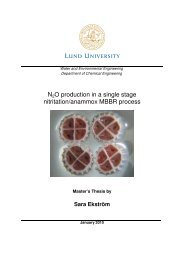Alexander Szabo and Oscar Engle - Svenskt Vatten
Alexander Szabo and Oscar Engle - Svenskt Vatten
Alexander Szabo and Oscar Engle - Svenskt Vatten
Create successful ePaper yourself
Turn your PDF publications into a flip-book with our unique Google optimized e-Paper software.
Figure 8.1: BOD 5 <strong>and</strong> COD in effluent from the northern treatment line on the 5-6 November 2009<br />
(before de-sludging).<br />
Figure 8.2: COD in effluent from the northern treatment line on the 9-10 January 2010 (after desludging).<br />
TSS in effluent<br />
The TSS levels are higher <strong>and</strong> show a different pattern after the de-sludging was carried out. The<br />
average TSS on the 5-6 November was 37 mg/l (Figure 8.3), but 22 mg/l on the 9-10 January<br />
(Figure 8.4). The reason for lower TSS values after de-sludging may be caused by many reasons.<br />
One reason is the fact that if the ponds had high levels of sludge, the volume of water in the<br />
ponds decreased, hence creating less retention time <strong>and</strong> higher water flow, which disturbs the<br />
settling process. If the sludge reaches a high level from the bottom of the pond, the distance<br />
between the top sludge layer <strong>and</strong> outlet channel gets narrower <strong>and</strong> more solid particles may get<br />
<br />
38















